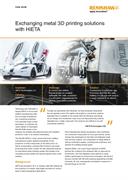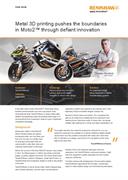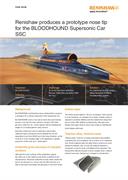Ta strona nie jest obecnie dostępna w Twoim języku. Możesz zapoznać się z tłumaczeniem automatycznym, korzystając z usługi Google Translate. Nie jesteśmy odpowiedzialni za świadczenie tej usługi, ani też wyniki tłumaczenia nie były przez nas sprawdzane.
Jeżeli chciałbyś uzyskać więcej pomocy skontaktuj się z nami.
Automotive
Latest additive manufacturing case studies.
Case studies
Exchanging metal 3D printing solutions with HiETA
Technology from Renishaw is helping HiETA to move metal additive manufacturing (AM) from prototype manufacture into commercial production of its specialist range of heat exchangers. In particular, the recent addition of Renishaw's RenAM 500M system at the company has enabled manufacturing times and, therefore production costs, to be reduced dramatically.
Metal 3D printing pushes the boundaries in Moto2™ through defiant innovation
Moto2 team TransFIORmers is using cutting edge metal additive manufacturing (3D printing) technology in an unconventional front suspension system to gain a significant competitive advantage.
Enhancing the additive manufacturing process chain
The design freedom provided by additive manufacturing (AM) or ‘3D printing' technology is an important enabler in cutting-edge product innovation. As part of the revolution in digital manufacturing, AM can radically simplify the production of complex parts, while simultaneously improving functional performance, reducing part weight and minimising component counts.
Renishaw produces a prototype nose tip for the BLOODHOUND Supersonic car
BLOODHOUND's aim is not only to break the sound barrier but also to be the first land vehicle to exceed 1 000 miles per hour (1609 km/hr) - at this speed it will be travelling the length of 4.5 football pitches every second.
The majority of the cockpit and nose is made from carbon fibre reinforced epoxy. During the record attempt the car will experience more than 20 000 kg of skin drag. However as the nose tip is on the ‘leading edge' it will experience a greater proportion of this load; up to 12 000 kg/m².
Additive manufacturing crosses the finishing line
Formula Student is Europe's most established educational motorsport competition, bringing together industry leaders, high profile engineers, universities and students from around the continent. The aim is to design and build a single-seater car which races on a course normally reserved for Formula 1. Formula Student is also a place where innovation is very much at home, particularly when it comes to new manufacturing methods and design engineering.
Industrial 3D printing yields success on the Formula Student circuits
Formula Student is an international student design competition that was initiated in the USA in 1981 by the Society of Automotive Engineers (SAE), and has been held in Europe since 1998. The fiercely competitive international competitions take place on race tracks in Europe, the USA and Asia, and each team decides individually in which competitions it would like to take part.











